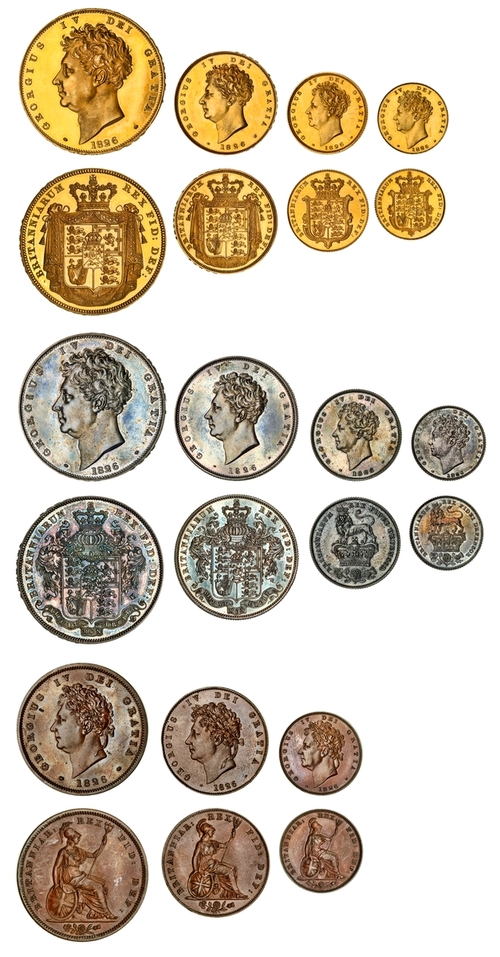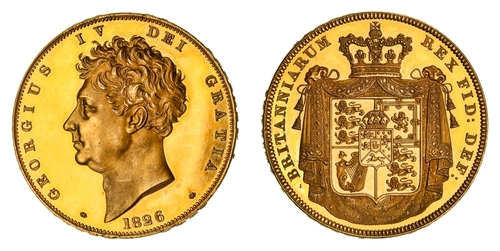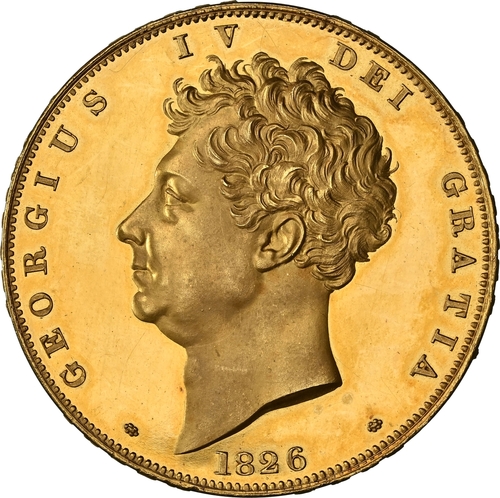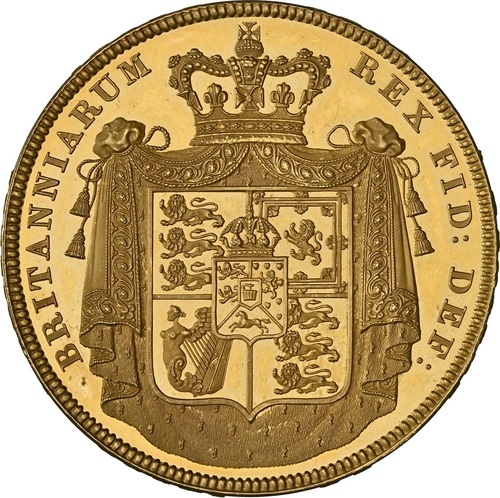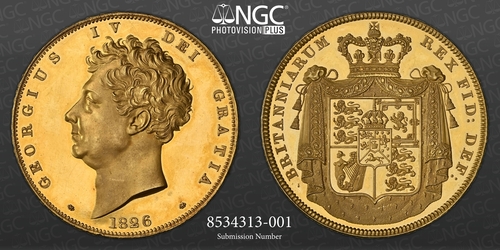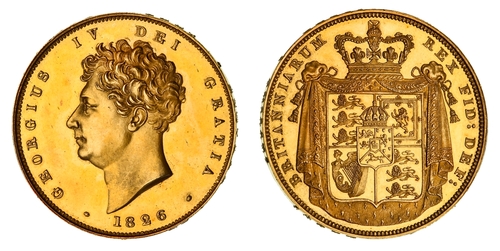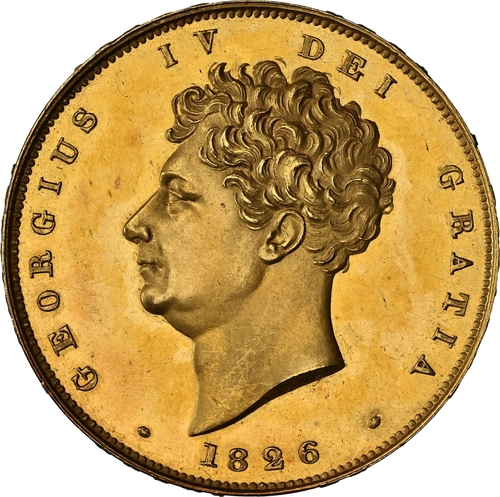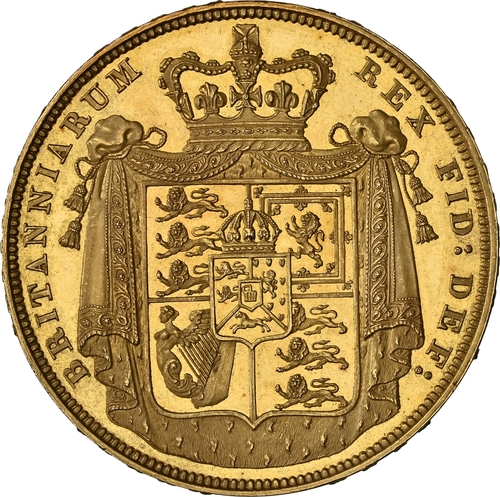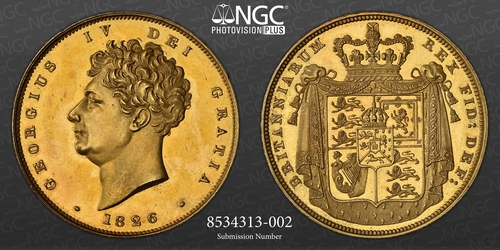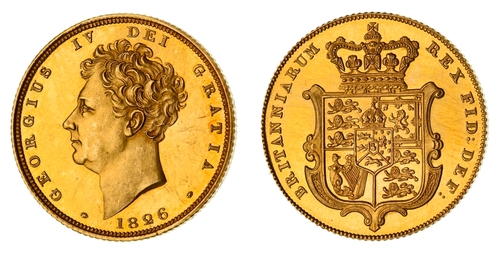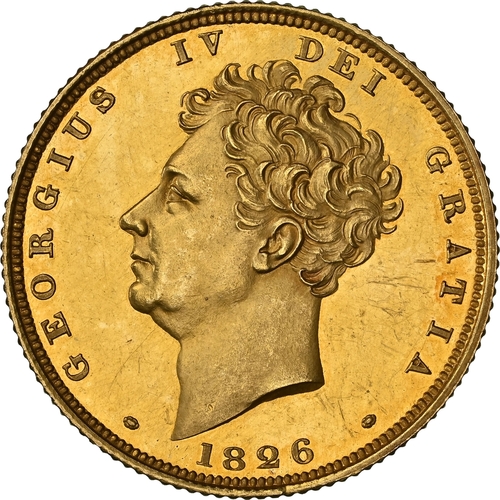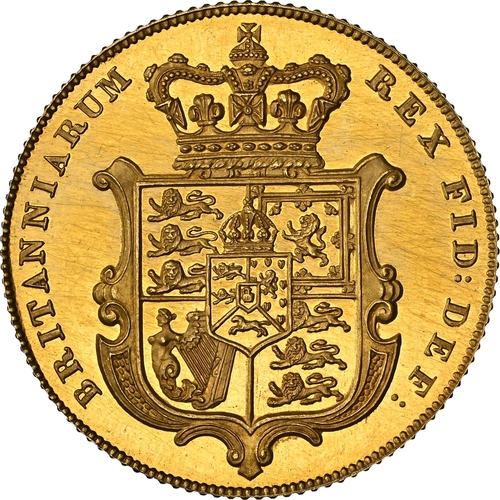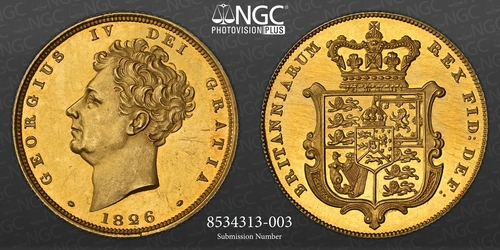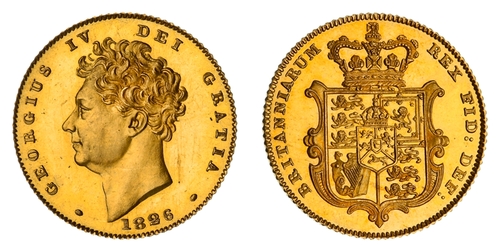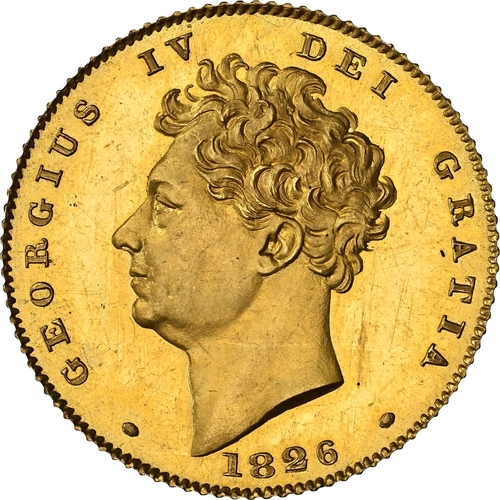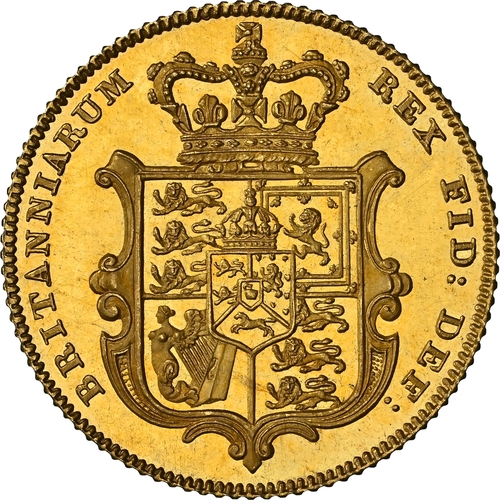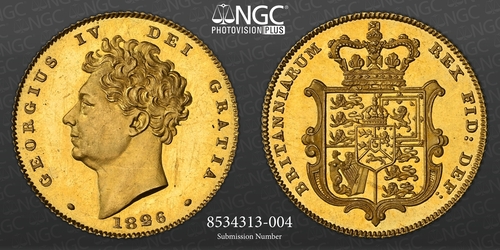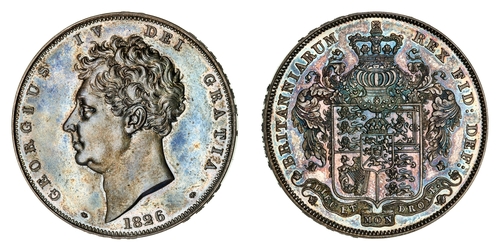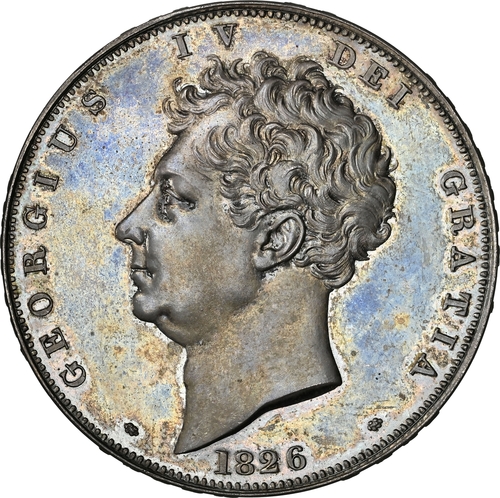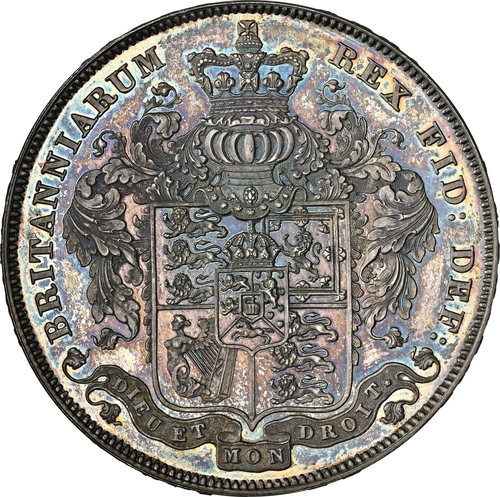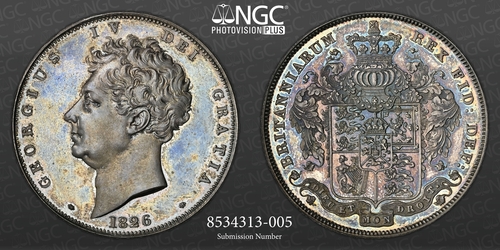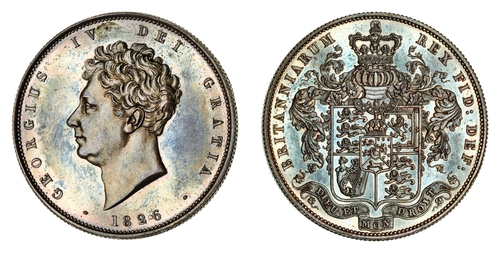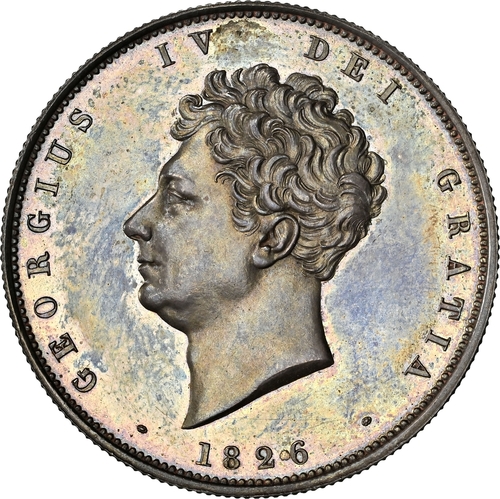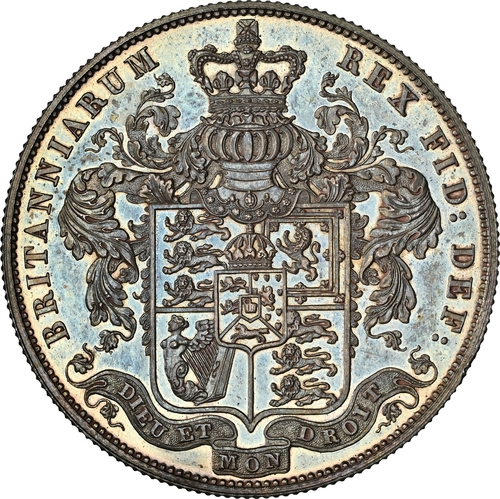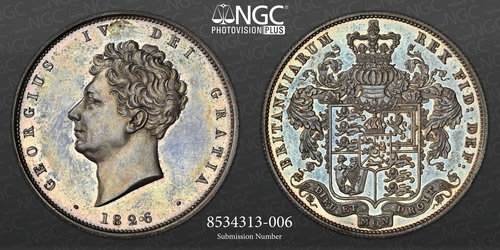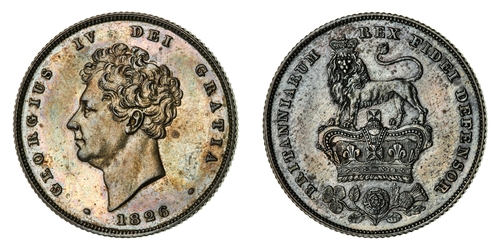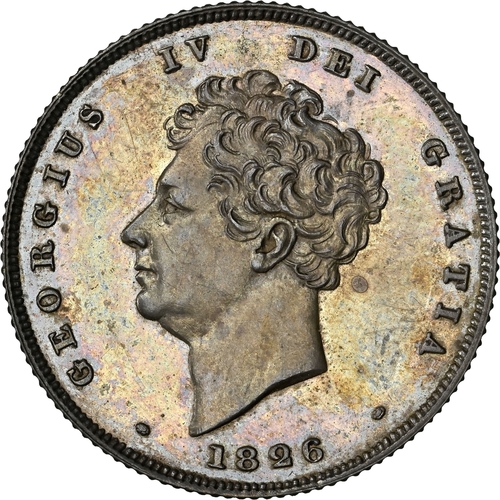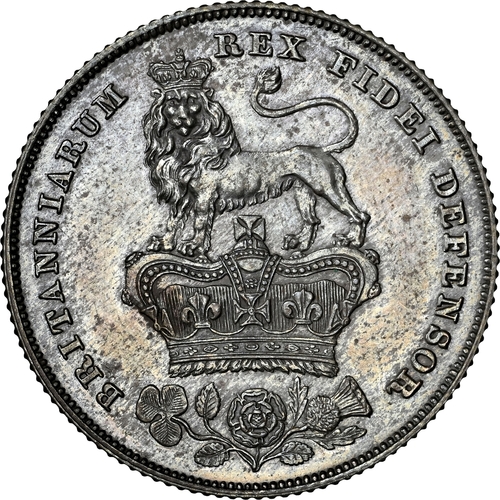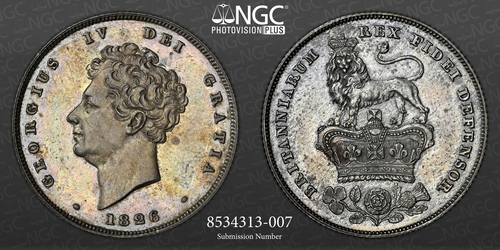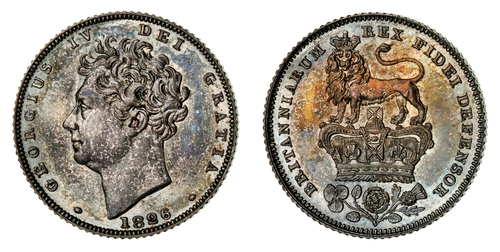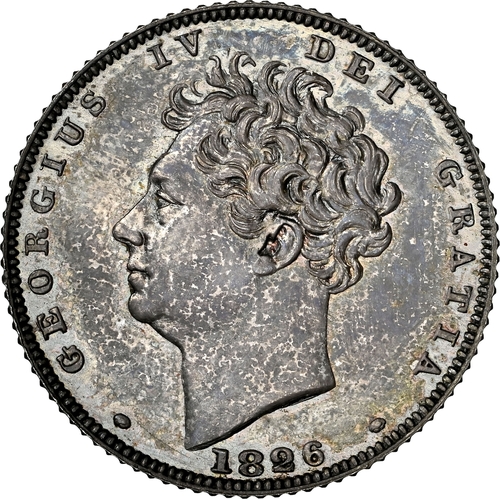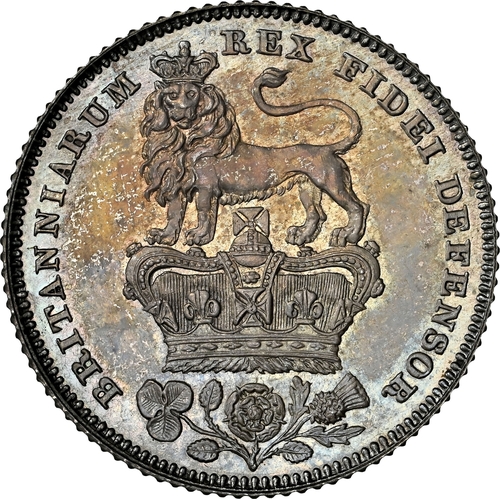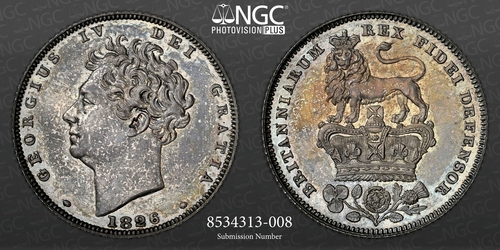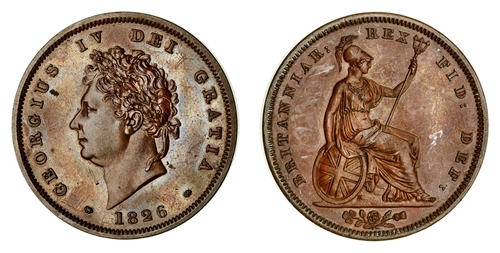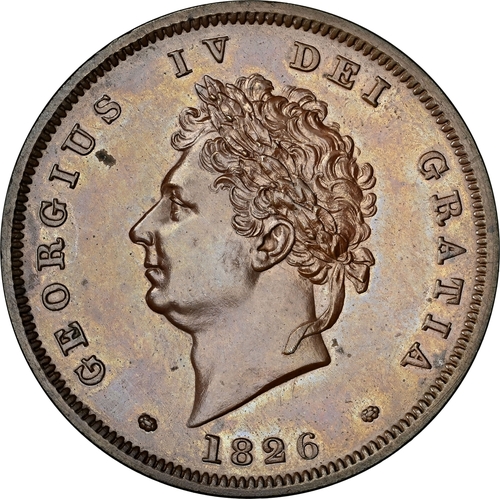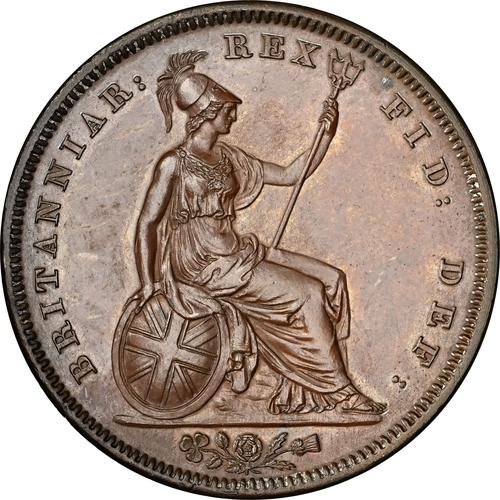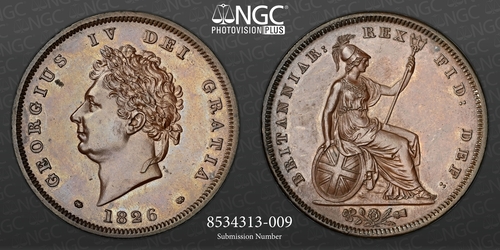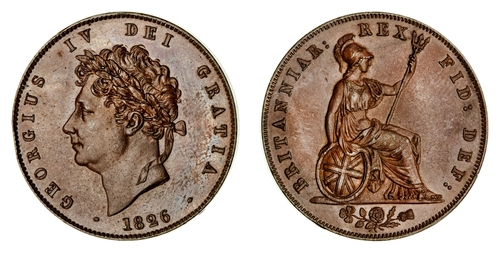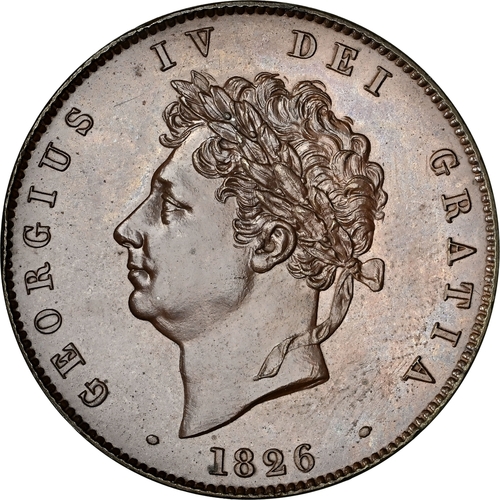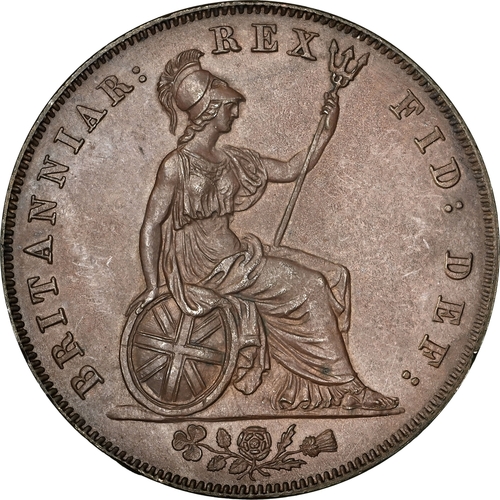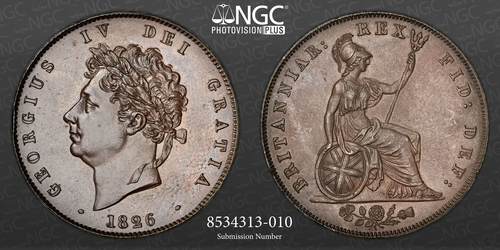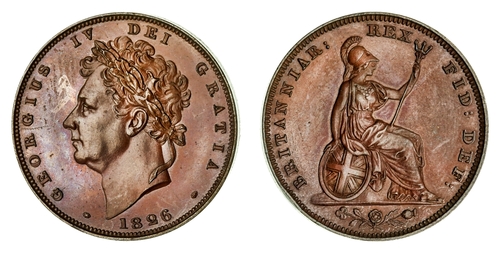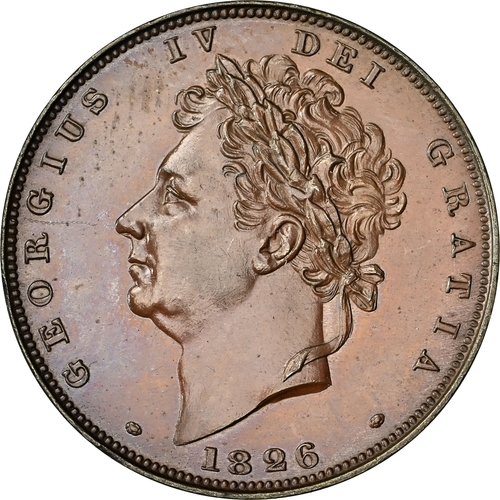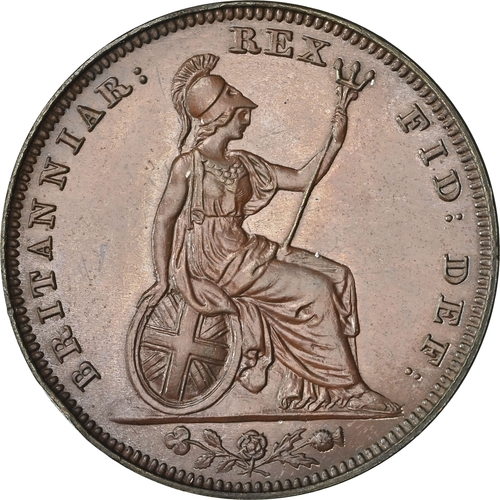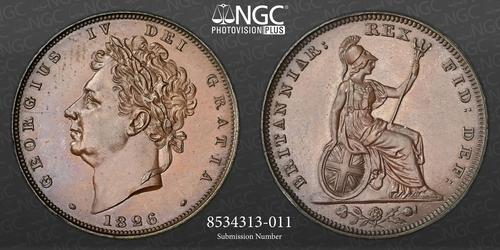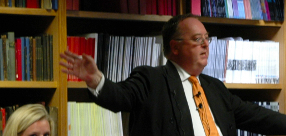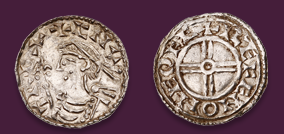Auction: 25005 - The Carrington and Pallas Collections of Exceptional English and Anglo-Gallic Gold Coins and Proof Sets
Lot: 473
(g) NGC PF64 UCAM - PF65BN | George IV (1820-1830), Proof Set, 1826 (11), Specimen Five-Pounds to Half-Sovereign, Crown to Sixpence, Penny to Farthing (S.PS1), a pleasingly honest and original set with glorious cabinet tone interspersed with mint brilliance on key pieces, a connoisseur's great opportunity!, with NGC Certification (Cert. #8534313) (11)
Provenance
The "Pallas" Collection of English Coins
Spink, by private treaty, 25 April 1983 - £20,600
i) PF64 UCAM | Proof Five-Pounds, 1826 SEPTIMO, edge lettered downwards, 39.874g, 6h (L&S 27; W&R 213; Marsh F6; GH 98; EGC II, 940 [R3]), some haziness in arresting pools of gloriously full and honest orange cabinet-tone, with sharp cameo definition, much as struck, a glorious specimen, in NGC 'Black' Pallas holder, graded PROOF 64 ULTRA CAMEO (Cert. #8534313-001)
ii) PF63 CAM | Proof Two-Pounds, 1826 SEPTIMO, edge lettered downwards, 15.951g, 6h (Douglas-Morris 168; W&R 228; EGC II, 957), highly superficial pecks to truncation and wisps of cabinet friction in otherwise brilliant fields, the portrait in pleasant contrast, a wholesome example, a bold extremely fine, in NGC 'Black' Pallas holder, graded PROOF 63 CAMEO (Cert. #8534313-002)
iii) PF61 CAM | Proof Sovereign, 1826, rev. eight hearts, edge milled, 7.971g, 6h (Stratos 216; W&R 237 [R2]; EGC II, 969), linear cabinet friction and deft handling marks in otherwise attractively brilliant fields, with sumptuous golden-orange cabinet toning, a most pleasingly honest and original example, a bolder extremely fine, in NGC 'Black' Pallas holder, graded PROOF 61 CAMEO (Cert. #8534313-003)
iv) PF65 UCAM | Proof Half-Sovereign, 1826, without 'extra tuft', edge milled, 3.985g, 6h (Douglas-Morris 153; Hill 407A; W&R 249; EGC II, 997), the deftest cabinet friction in otherwise brilliant fields, a beautifully honest and wholesome example of this treasured rarity, virtually as struck, in NGC 'Black' Pallas holder, graded PROOF 65 ULTRA CAMEO (Cert. #8534313-004)
v) PF65 | Pattern Proof Crown, 1826 SEPTIMO, edge lettered downwards, 28.168g, 6h (L&S 27; Bull 2336; ESC 257; Davies 151), an outstanding example, richly and deeply cabinet toned overlying brilliant original fields, practically FDC, in NGC 'Black' Pallas holder, graded PROOF 65 (Cert. #8534313-005)
vi) PF64 | Proof Halfcrown, 1826, edge milled, 14.078g, 6h (Bull 2376; ESC 647; Davies 192; MCE [1950], p. 106, 'Reverse 3' this coin), the reverse and milling concreted with red wax where previous plated, otherwise outstandingly cabinet toned with petrol-blue hues, much as struck, in NGC 'Black' Pallas holder, graded PROOF 64 (Cert. #8534313-006)
vii) PF62 | Proof Shilling, 1826, edge milled, 5.674g, 7h (Bull 2411; ESC 1258), some surface marks in brilliant but very darkly toned fields, a bold extremely fine, in NGC 'Black' Pallas holder, graded PROOF 62 (Cert. #8534313-007)
viii) PF63 | Proof Sixpence, 1826, "extra tuft", edge milled, 2.833g, 7h (Bull 2435; ESC 1663), spots of red wax in previously wiped but brilliant and darkly retoned fields, a pleasingly bold extremely fine, in NGC 'Black' Pallas holder, graded PROOF 63 (Cert. #8534313-008)
ix) PF64 BN | Bronzed Proof Penny, 1826, rev. Rev. C, thick raised line on saltire, edge plain, 19.224g, 12h (BMC [Peck] 1426), some carbon spotting and organic residue to peripheries, otherwise brilliant, a pleasingly good extremely fine, with harmonious chocolate brown patination, in NGC 'Black' Pallas holder, graded PROOF 64 BROWN (Cert. #8534313-009)
x) PF64 BN | Bronzed Proof Halfpenny, 1826, rev. Rev. A, two incuse lines on saltire, edge plain, 9.525g, 12h (BMC [Peck] 1434), small rim bruise at 8 o'clock, other brilliant, a really bold extremely fine and much as issued, in NGC 'Black' Pallas holder, graded PROOF 64 BROWN (Cert. #8534313-010)
xi) PF65 BN | Bronzed Proof Farthing, 1826, edge plain, 4.699g, 12h (BMC [Peck] 1440), small rim bruise at 8 o'clock on reverse, otherwise brilliant, good extremely fine, in NGC 'Black' Pallas holder, graded PROOF 65 BROWN (Cert. #8534313-011)
The Morning Post (27 October 1826), reports: 'A new coinage of gold, silver and copper has just been completed at the Mint. Four or Five of the principal bankers had each one set as a specimen, and no more. A set consists of one 5l. piece, one 2l. piece, a 1l. piece, and a 10s. piece (gold); a 5s. piece, a half-crown piece, a 1s and a 6d. (silver); a penny, a half-penny, and a farthing in copper. The 5l. piece bears on one side the arms of Great Britain engraved on drapery, with the motto DECUS ET TUTAMEN, and the date of the year: on the other side, the head of His Majesty, similar to the one on the new Sovereign. This piece is supposed to be taken from the forty Liri piece of Parma. The 2l. piece is the same as the above; the 1l. piece is also the same, but not engraved on drapery. The 5s. piece, the half-crown piece, the 1s. and 6d. bear the arms of Great Britain, the same as these already issued. The penny, half-penny and farthing, dated 1826.
This enlightening report provides further background to a contemporary fiscal policy to withdraw the Bank of England's circulation of one and two pound bank notes by April 1829. However, opponents at the time feared a rush to gold requiring an extra 5 million gold pounds to cover the promissory short fall explaining the subsequent upsurge in mint productions of Sovereigns for 1825 and 1826.
The Globe continues (Friday, 27 October 1826): 'We yesterday announced the completion of a new coinage. As these new coinages are frequently made at some expence to the public, we are at a loss to know why the larger gold coins (the 5l. and 2l. coins) are not put into circulation? In some cases these coins would be convenient as currency, and like crowns and half-crowns in silver, would save trouble in counting. At any rate, if the expence of making the dies be incurred, as many of them should be put into circulation as the public demand, instead of making them, as at present, artificially scarce, for the purpose of apparently giving them a value in the absurd estimation of collectors. Even these worthies might be satisfied, if there were proof impressions exclusively for them.
On Thursday 11 January 1827, the Devizes and Wiltshire Gazette ran the story of a break in at Chilton Lodge, the dwelling house of one John Pearse MP. 'During the night of Saturday the 30th of Dec. 1826, thieves forced the locks and ransacked the drawers of the principal rooms of the ground floor and stole the following articles....a silver inkstand, a French Gold repeating watch and proof Impressions of the Coin of the Present reign, George the 4th. IN GOLD - A Five Sovereign; a Two Sovereign; a Sovereign and a Half-Sovereign. IN SILVER - A Five Shilling Piece; a Half-Crown; a Shilling; a Sixpence. IN COPPER - a Penny; a Halfpenny; a Farthing.' Besides serving his Hungerford parliamentary constituency for over a decade, he would also occupy the seat of Director of the Bank of England (1812-1828), and was therefore evidently one of our original four of five recipients of the October 1826 strikings.
For collectors however the wait would be rather longer to legitimately obtain examples. The dispersals of Mr Ralph Willett (Sotheby's, 15 March 1827) and Royal Mint Engraver John Milton (Sotheby's, 23 April 1827) did not offer the new proofs, despite both gentlemen clearly having the means and the access to them. In fact it is not until the sale of the appropriately named Mr Rich (Sotheby's, 7 July 1828, lot 189), that a similarly designed 1825 Proof Halfcrown appears at public auction, with examples of the specimen copper specie following with the sale of the late Joseph Miller of Barnard's Inn, Holborn (Sotheby's, 25 February 1829, lot 180).
The death of William Simonds Higgs afforded the market the earliest auction record this cataloguer can trace for the offering of a full set (Sotheby, 29 April 1830, lot 313), wherein the description simply states: 'His present Majesty's Proof Coins, from the Five Sovereign Piece to the Farthing', by. W. Wyon, in a morocco case' - £4.13.6 [Higgs]. This would suggest the lot was bought in by the estate, having extraordinarily failed to reach even its face value. The following year the result would not be replicated with the sale of esteemed collection of Mr Barclay's cabinet in Sotheby's rooms (21-23 March 1831). His 1826 Proof set would be split up into a group lot of the silver pieces (lot 321 - £1.14.0) and individual and paired lots for the gold (£5 - lot 364 - £8.10.6; £2 - lot 365 - £4.0.0; £1 and Half-Sovereign - lot 366 - £2.2.0). Most interestingly of all is the description for the subsequent lot 367 which alludes directly to the Globe's earlier commentary: 'George IV. UNIQUE PATTERNS with plain edges. IN FINE GOLD, of the beautiful FIVE-SOVEREIGN and TWO SOVEREIGN PIECES, 1826, by William Wyon; weight 1oz. 8 dwt. 12grs and 13 dwt. 18gr. - Struck by order of the Right Honourable T. Wallace for this collection. - £21.18.0 (W&R 214). An example of just such a contemporary plain edge specimen is offered elsewhere in this sale.
Subject to 20% VAT on Buyer’s Premium. For more information please view Terms and Conditions for Buyers.
Sold for
£155,000
Starting price
£85000

